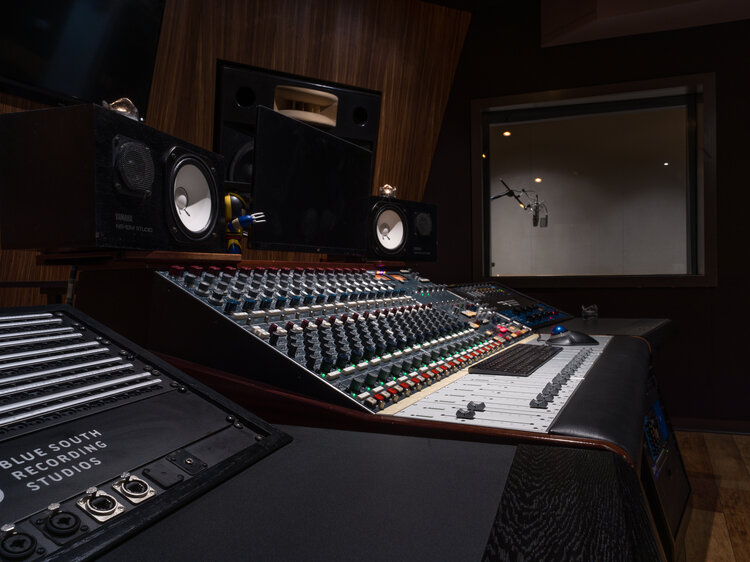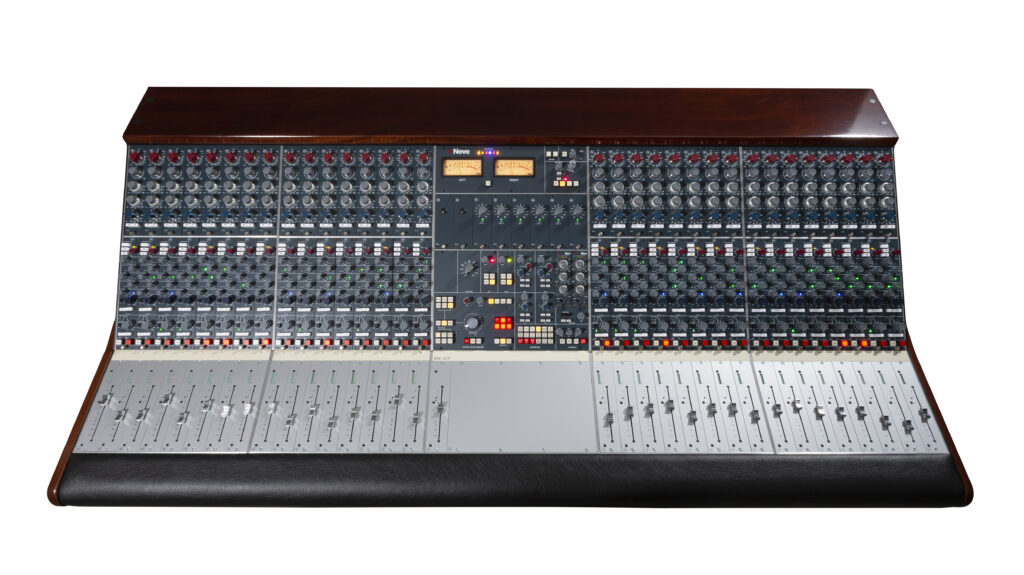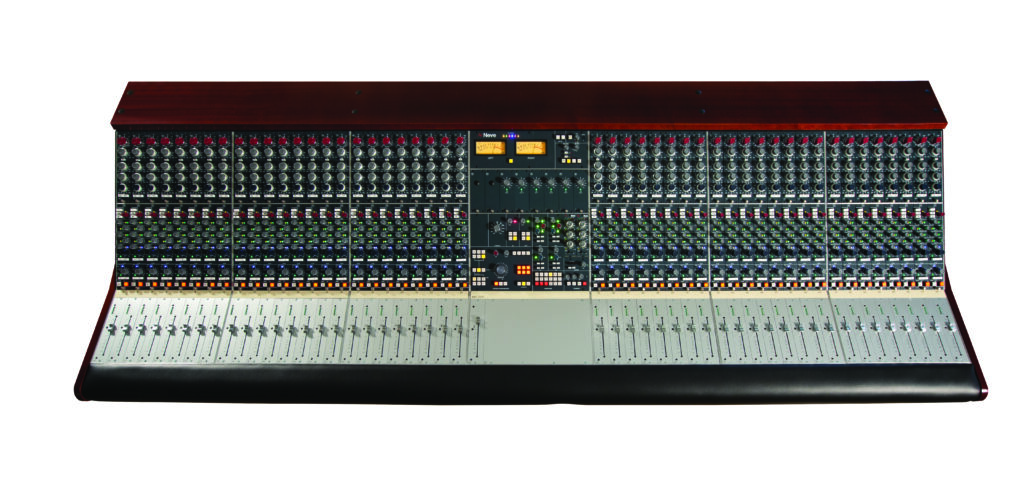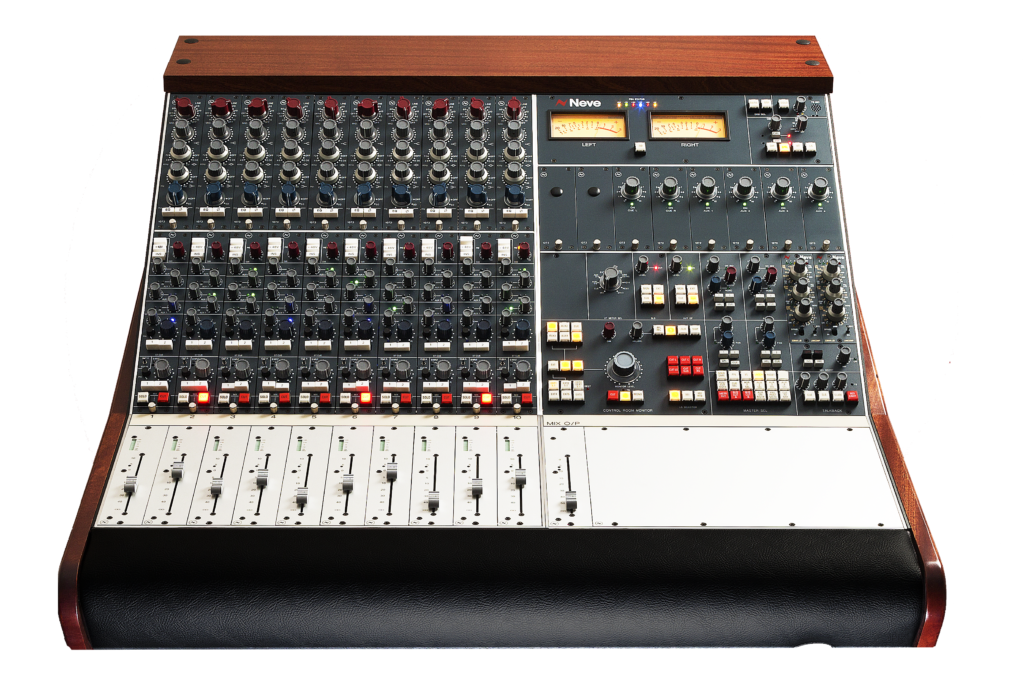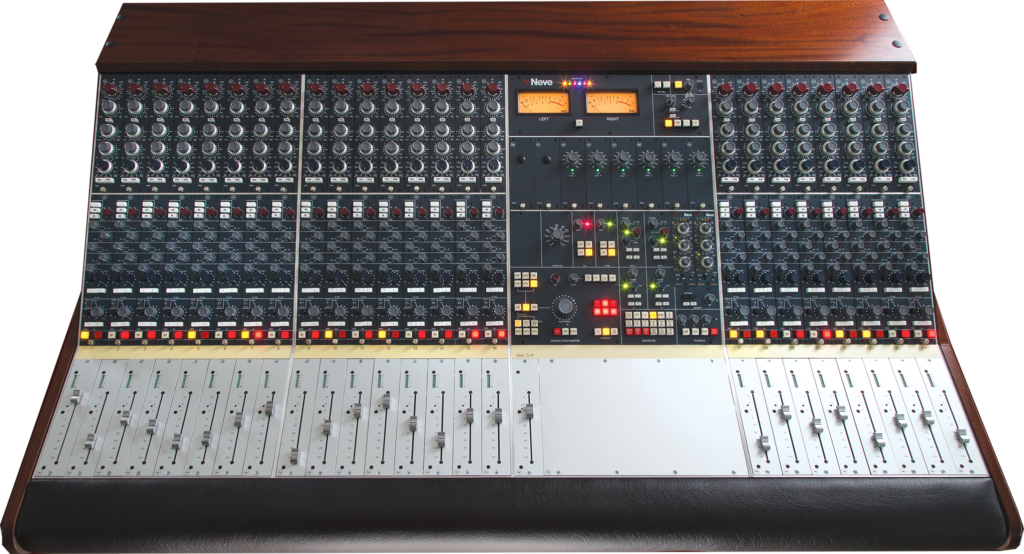Overview
BCM10/2 Mk2
Class-A Legend
Designed in 1969, the classic BCM10’s class-A design, transformer balanced topology delivered ultimate audio performance throughout the golden era of studio recording. The modern BCM10/2 MkII introduces routing & monitoring options for use in today’s studios, with multiple configurations to allow any artist, producer and engineer to harness the iconic Neve® sound.
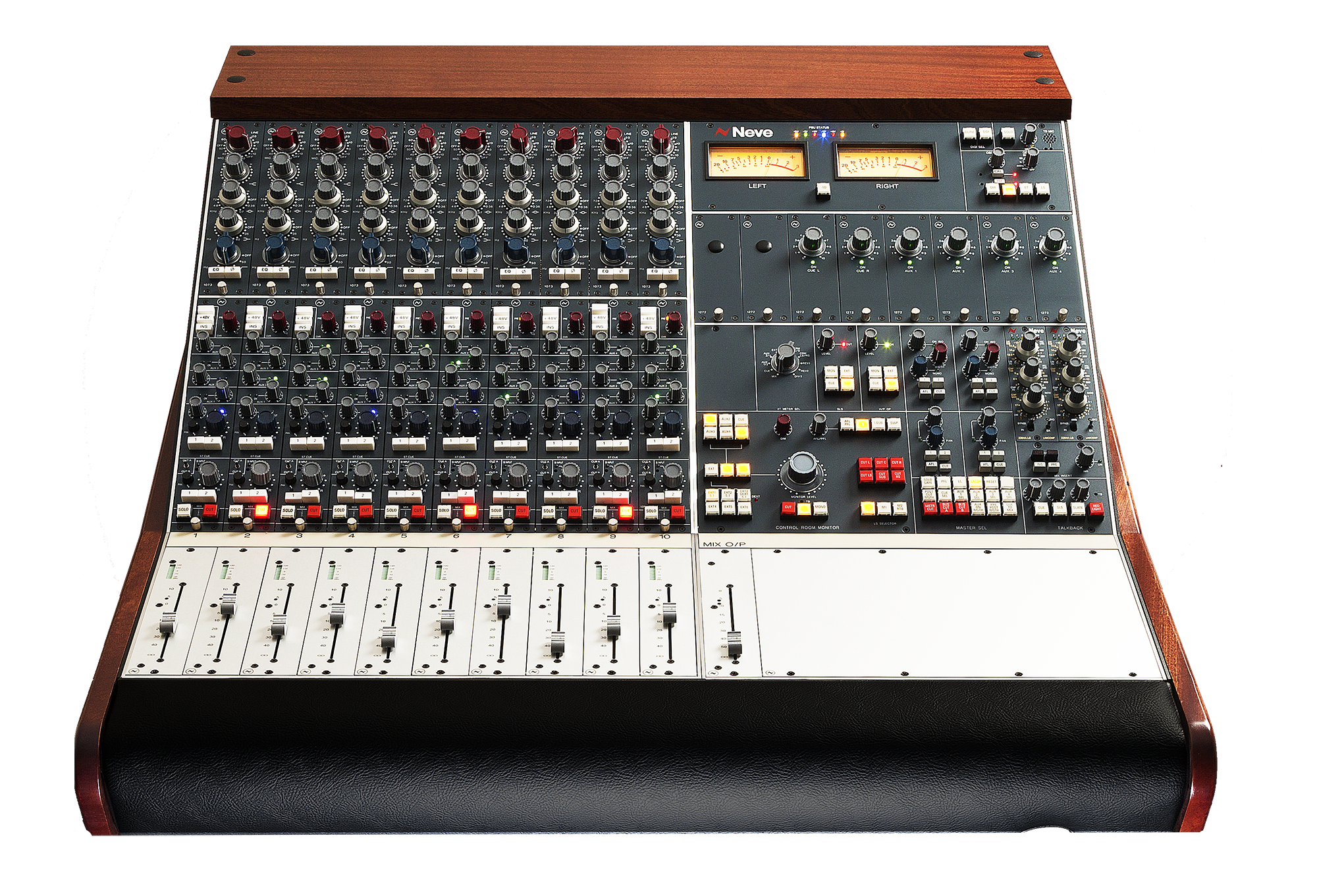
BCM10/2 Mk2
NEVE CLASSIC SOUND USING CLASS A TOPOLOGY
Designed in 1969, the classic BCM10 was the ultimate tracking console for the world’s premier studios. It’s class A design, transformer balanced topology, and 1073 modules delivered the ultimate in audio performance throughout the golden era of studio recording.
When designing the modern BCM10/2 Mk2, Neve engineers painstakingly reverse–engineered the classic BCM10 console. No expense was spared when sourcing original components in order to deliver the legendary Neve sound heard on countless recordings spanning the past five decades.
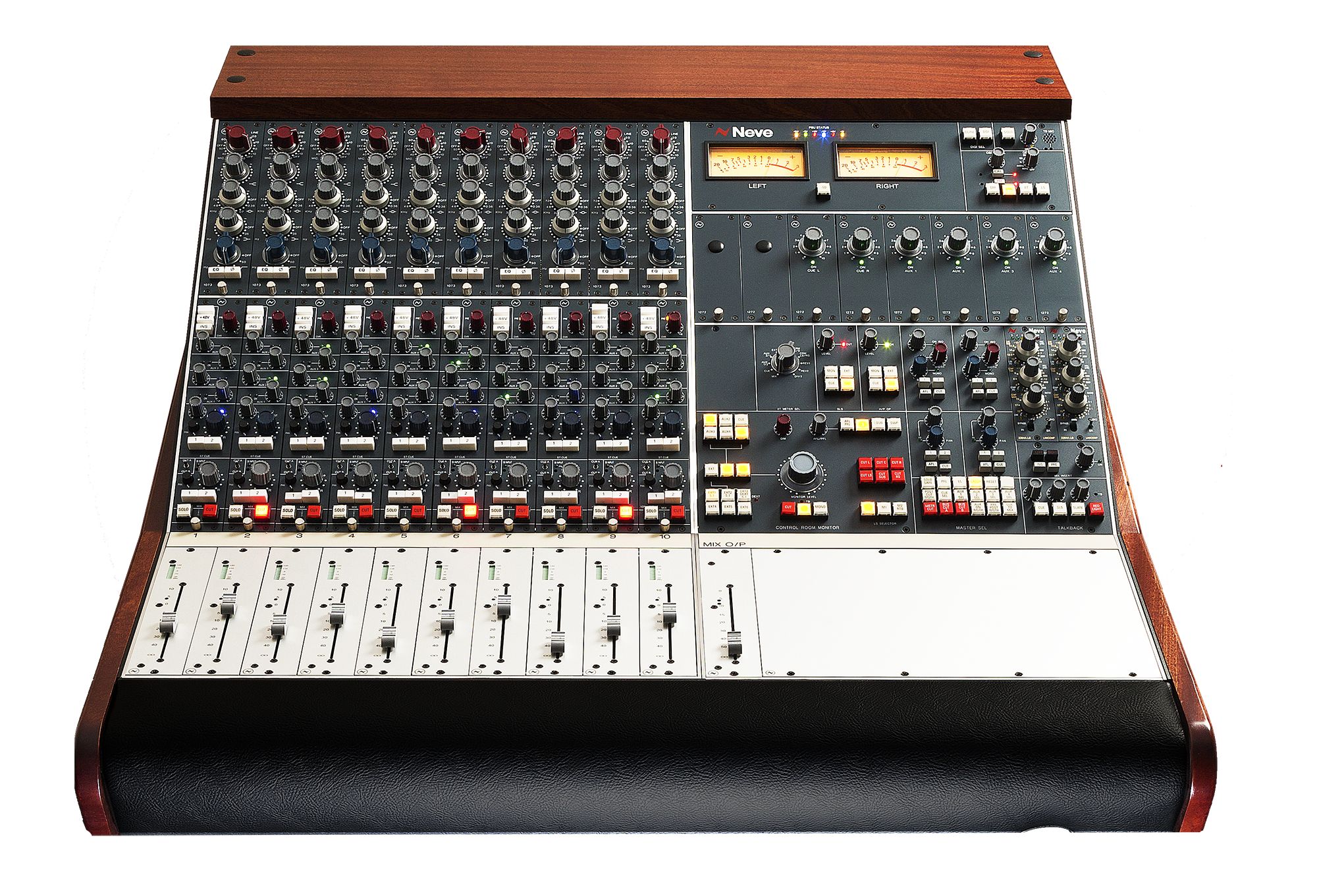
360° – Click & Drag
Premium Front-End
80-Series Modules
The BCM10/2 MkII 80-series module slots can house the classic hand-built 1073®, 1084 preamps or the modern 1073N, each with class A topology and Marinair® Transformers.
1073® Preamps
All module options feature the world-famous 1073® preamp, capable of producing up to 80dB of mic gain by layering transistor gain stages on top of each other. This unique design lets you dial in the precise gain levels via the 5dB switch and, if required, drive the preamp to produce subtle harmonic saturation.
Marinair Transformers
The BCM’s 1073®, 1084, or 1073N modules use exclusive Marinair® specification transformers to balance the microphone input, line input and output stage, helping to create the unique character of this classic console.
Inductor-Based EQ
The three-band EQ from the 1073®, 1084 or 1073N uses exclusive, hand-wound inductors to produce musical, sound sculpting results. This equaliser, complimented with a choke-coupled high pass filter, gives complete control over the frequency spectrum.
Switchable HPF
The famous 1073 18dB/octave high pass filter is ideal for cutting out unwanted low frequencies and delivering complete control over the frequency spectrum, with 1084 modules installed, frequency control is enhanced with the addition of a switchable low pass filter.
1073/1084 EQ
For those looking for further EQ control, the 1084 modules use the same preamp design as the 1073® but feature an expanded EQ palette with selectable high-frequency bands, low pass filter and mid-band Hi-Q setting.
Modern Bussing & Connectivity
1252 Module
The new 1952 channel routing module handles channel bussing and routing, featuring modern switching options for current studio needs.
Switchable Insert
Each channel features a switchable, balanced insert, perfect for connecting to a patch bay or directly into outboard processors.
Direct Outputs
For tracking or stem mixing, each channel has a direct output with up to +10dB in hand, switchable to pre or post the insert point.
Dual-Path Mixing
One of the modern additions to the classic BCM is the simple input feature. This additional transformer-balanced line input transforms the console into an in-line mixer and doubles the consoles channel count when mixing large sessions.
Aux & Cue Sends
The modern BCM10/2 Mk II busing system expands upon the capabilities of the original console with four mono pre/post fader aux sends and a stereo cue send, perfect for connecting to outboard FX and performer headphone systems.
P&G Faders
Smooth action P&G faders complimented with 7-stage LED metering deliver a precise visual overview of levels when tracking or mixing.
1252 Module
The new 1952 channel routing module handles channel bussing and routing, featuring modern switching options for current studio needs.
Switchable Insert
Each channel features a switchable, balanced insert, perfect for connecting to a patch bay or directly into outboard processors.
Direct Outputs
For tracking or stem mixing, each channel has a direct output with up to +10dB in hand, switchable to pre or post the insert point.
Dual-Path Mixing
One of the modern additions to the classic BCM is the simple input feature. This additional transformer-balanced line input transforms the console into an in-line mixer and doubles the consoles channel count when mixing large sessions.
Aux & Cue Sends
The modern BCM10/2 Mk II busing system expands upon the capabilities of the original console with four mono pre/post fader aux sends and a stereo cue send, perfect for connecting to outboard FX and performer headphone systems.
P&G Faders
Smooth action P&G faders complimented with 7-stage LED metering deliver a precise visual overview of levels when tracking or mixing.
Class-A Topology
Voltage Mixing
The BCM10/2 MkII uses voltage mixing across its mix busses; this classic architecture reduces the mix bus gain to be reamplified through the 1272’s to line level. This process creates a ‘pleasant analogue hue compared to modern, transparent, current mixing and forms part of the BCM’s unique sonic character.
1272 Modules
The classic Neve® 1272 line amplifier modules have been given new life in the modern BCM10 console. Every 1272 works across its associated mix bus to reamplify the signal similarly to vintage Neve preamps, boosting it through Marinair Transformers.
Class A Discrete
The modern BCM 10/2 MkII uses class-A discrete architecture throughout. Neve® engineers painstakingly revived the original circuits to preserve the classic Neve console character.
Transformer-Balanced Design
In addition to the Marinair transformers found in the channel modules, almost every input and output to the console is transformer-balanced, including the 1952 A&B line inputs, channel simple inputs, mix bus channel inputs, reverb returns and each 1272 module input & output. In total, a ten-channel BCM10/2 MkII uses 104 Marinair specification transformers!
External PSU
In the BCM10/2 MkII, everything is discrete, including the power supply. The quiet running, external 3U 19″ rackmount PSU module can be housed in the control room or a service room, keeping the analogue and power cables separate.
Cherry Oak Finish
The BCM10/2 MkII is classic through and through. The console’s side trim and speaker shelf styling use genuine cherry oak sourced from the local area, less than 20 miles from Neve® HQ.
Voltage Mixing
The BCM10/2 MkII uses voltage mixing across its mix busses; this classic architecture reduces the mix bus gain to be reamplified through the 1272’s to line level. This process creates a ‘pleasant analogue hue compared to modern, transparent, current mixing and forms part of the BCM’s unique sonic character.
1272 Modules
The classic Neve® 1272 line amplifier modules have been given new life in the modern BCM10 console. Every 1272 works across its associated mix bus to reamplify the signal similarly to vintage Neve preamps, boosting it through Marinair Transformers.
Class A Discrete
The modern BCM 10/2 MkII uses class-A discrete architecture throughout. Neve® engineers painstakingly revived the original circuits to preserve the classic Neve console character.
Transformer-Balanced Design
In addition to the Marinair transformers found in the channel modules, almost every input and output to the console is transformer-balanced, including the 1952 A&B line inputs, channel simple inputs, mix bus channel inputs, reverb returns and each 1272 module input & output. In total, a ten-channel BCM10/2 MkII uses 104 Marinair specification transformers!
External PSU
In the BCM10/2 MkII, everything is discrete, including the power supply. The quiet running, external 3U 19″ rackmount PSU module can be housed in the control room or a service room, keeping the analogue and power cables separate.
Cherry Oak Finish
The BCM10/2 MkII is classic through and through. The console’s side trim and speaker shelf styling use genuine cherry oak sourced from the local area, less than 20 miles from Neve® HQ.
Mix Processing & Routing
Mix Bus Inserts
The BCM10/2 MkII includes two stereo mix bus inserts, ideal for custom bus processing final signals, and the IMR blend allows for parallel processing with single-knob controls.
500 Series Slots
To further enhance the mix bus processing capabilities of the BCM10/2 MkII, two VPR alliance specification 500 series slots are included, allowing for any 500 series processor to be applied across the mix bus.
Dual D.I Inputs
Dual DI inputs with cue send, AFL, and solo isolation can bring additional signals from external mixers into the BCM mix bus or connect an external mixer into the performer cue mix systems.
Dual Reverb Returns
Dual reverb returns with stereo width, cue send, AFL, and solo isolation are dedicated systems for connecting outboard FX processors back into the console.
Mute Groups & Smart Switching
Global controls for aux on/off & pre/post fade state make session routing simple, plus two independent cut groups for tracking or mixing.
Solo System
Three professional destructive and non-destructive solo modes – solo-in-place, after-fader-listen, and pre-fader-listen are perfect tools for tracking, mixing and overdubbing.
Mix Bus Inserts
The BCM10/2 MkII includes two stereo mix bus inserts, ideal for custom bus processing final signals, and the IMR blend allows for parallel processing with single-knob controls.
500 Series Slots
To further enhance the mix bus processing capabilities of the BCM10/2 MkII, two VPR alliance specification 500 series slots are included, allowing for any 500 series processor to be applied across the mix bus.
Dual D.I Inputs
Dual DI inputs with cue send, AFL, and solo isolation can bring additional signals from external mixers into the BCM mix bus or connect an external mixer into the performer cue mix systems.
Dual Reverb Returns
Dual reverb returns with stereo width, cue send, AFL, and solo isolation are dedicated systems for connecting outboard FX processors back into the console.
Mute Groups & Smart Switching
Global controls for aux on/off & pre/post fade state make session routing simple, plus two independent cut groups for tracking or mixing.
Solo System
Three professional destructive and non-destructive solo modes – solo-in-place, after-fader-listen, and pre-fader-listen are perfect tools for tracking, mixing and overdubbing.
Powerful Monitor Controls
Stepped Monitor Control
The stepped, triple-gang, gold-plated monitor switch delivers accurate levels for its many possible outputs, including signal blending options and internal and external signal sources. Additional monitor controls – mono sum, individual speaker cuts and variable speaker dim are powerful tools for modern professionals.
5.1 Monitoring
The BCM10/2 MkII powerful monitor section features three 5.1 external sources and three stereos. With 5.1 monitor outputs, the BCM can be the centre of any surround system without the need for external monitor controls.
Three Loudspeaker Outputs
The BCM10/2 MkII features three loudspeaker outputs, one complete 5.1 system and two stereo outputs; each output has independent trim controls for finely tuning your studio monitoring.
Headphones & SLS System
The SLS (studio loudspeaker system) and headphone output have independent source selections, level control and talkback facilities. These outputs can be used as named or as separate cue bus systems.
Talkback & Return Talkback
Talkback to cue, SLS and slate allow for seamless communication between engineer and artist, with a two-mode return talkback system for either two-way communication between artist and engineer or three-way between producer, artist and engineer.
Large VU Meters
The console centre’s large, backlit VU meters visually reference eleven selectable stereo mix bus signals. The VU meters feature -10dB attenuation allowing for accurate metering when pushing the console mix output.
Stepped Monitor Control
The stepped, triple-gang, gold-plated monitor switch delivers accurate levels for its many possible outputs, including signal blending options and internal and external signal sources. Additional monitor controls – mono sum, individual speaker cuts and variable speaker dim are powerful tools for modern professionals.
5.1 Monitoring
The BCM10/2 MkII powerful monitor section features three 5.1 external sources and three stereos. With 5.1 monitor outputs, the BCM can be the centre of any surround system without the need for external monitor controls.
Three Loudspeaker Outputs
The BCM10/2 MkII features three loudspeaker outputs, one complete 5.1 system and two stereo outputs; each output has independent trim controls for finely tuning your studio monitoring.
Headphones & SLS System
The SLS (studio loudspeaker system) and headphone output have independent source selections, level control and talkback facilities. These outputs can be used as named or as separate cue bus systems.
Talkback & Return Talkback
Talkback to cue, SLS and slate allow for seamless communication between engineer and artist, with a two-mode return talkback system for either two-way communication between artist and engineer or three-way between producer, artist and engineer.
Large VU Meters
The console centre’s large, backlit VU meters visually reference eleven selectable stereo mix bus signals. The VU meters feature -10dB attenuation allowing for accurate metering when pushing the console mix output.
The Connoisseurs Choice
From our Community
Abbey Road
Sony Music
Royal Blood
An Expert Overview
Explore the BCM 10/II Mk2 with Chief Analogue Designer Robin Porter
More Information and Support
General Specification
- Neve® classic sound using Class A topology
- Console sizes: 10,16,24, 32 or 48 channels
- 1073N microphone preamp and EQ module in each channel
- Classic voltage mixing using 1272 balanced mixing topology
- 2x 500-series slots fitted with Neve 2264ALB compressors, patchable or selectable across the Mix Bus
- Direct outputs on every channel selectable pre or post channel insert
- Simple Input to each channel doubles the mix inputs when mixing and also allows monitor and cue mixes
- 4x Auxes, 1x Stereo Cue, 1x Stereo Main Mix Bus
- Stereo and 5.1 monitor with passive 24 position gold plated monitor level control
- 3x Stereo & 1x 5.1 selectable loudspeaker output sets
- Comprehensive Solo system with destructive and safe/isolate modes
- 2x Stereo reverb returns with width, mono and balance controls & 2x mono DI to bus inputs
- Main Mix output insertion selectable pre or post fade with IMR (Insert Mix Return) parallel processing controls
- 25-way D-sub connectivity for easy installation into home or studio environments
Audio Performance
Mic Input (Transformer-balanced) to Insert Send
- Headroom – >+28.5dBu @ 10kohms bridging (<0.5% THD+N)
- Frequency Response – Typically +/- 0.25dB, 20Hz to 20kHz
- Distortion (THD+N) – Typically 0.028% @ 1kHz (measured at +20dBu 10Hz to 80kHz filter)
- Noise (EIN) – <-126.0 dBu (20Hz to 22kHz filter, 60dB gain, input terminated 150Ω R)
Line Input to Mix Output
- Headroom – >+28.5dBu @ 10kohms bridging (<0.5% THD+N)
- Frequency Response – Typically +/- 0.25dB, 20Hz to 20kHz
- Distortion (THD+N) – Typically 0.028% @ 1kHz (measured at +20dBu 10Hz to 80kHz filter)
- Noise (EIN) – <-126.0 dBu (20Hz to 22kHz filter, 60dB gain, input terminated 150Ω R)
- Mix bus Noise – typically -86dBu 20Hz to 20kHz filter
- Output noise – typically -95dBu 20Hz to 20kHz filter
Dimensions
- Height (on stand) to top of speaker shelf – 998mm (39.2 inches)
- Height (on stand) to top of faders – 754mm (29.6 inches)
- Height (without stand) to top of speaker shelf – 455mm (17.9 inches)
- Height (without stand) to top of faders – 210mm (8.2 inches)
- Depth – 1096mm (43.1 inches)
- Width (10 channel console) – 878mm (34.5 inches)
- Width (16 channel console) – 1158mm (45.5 inches)
- Width (16 channel console with producers table) – 1900mm (74.8 inches)
- Width (24 channel console) – 1529mm (60.1 inches)
- Width (24 channel console with producers table) – 2271mm (89.4 inches)
- Width (32 channel console) – 1900mm (74.8 inches)
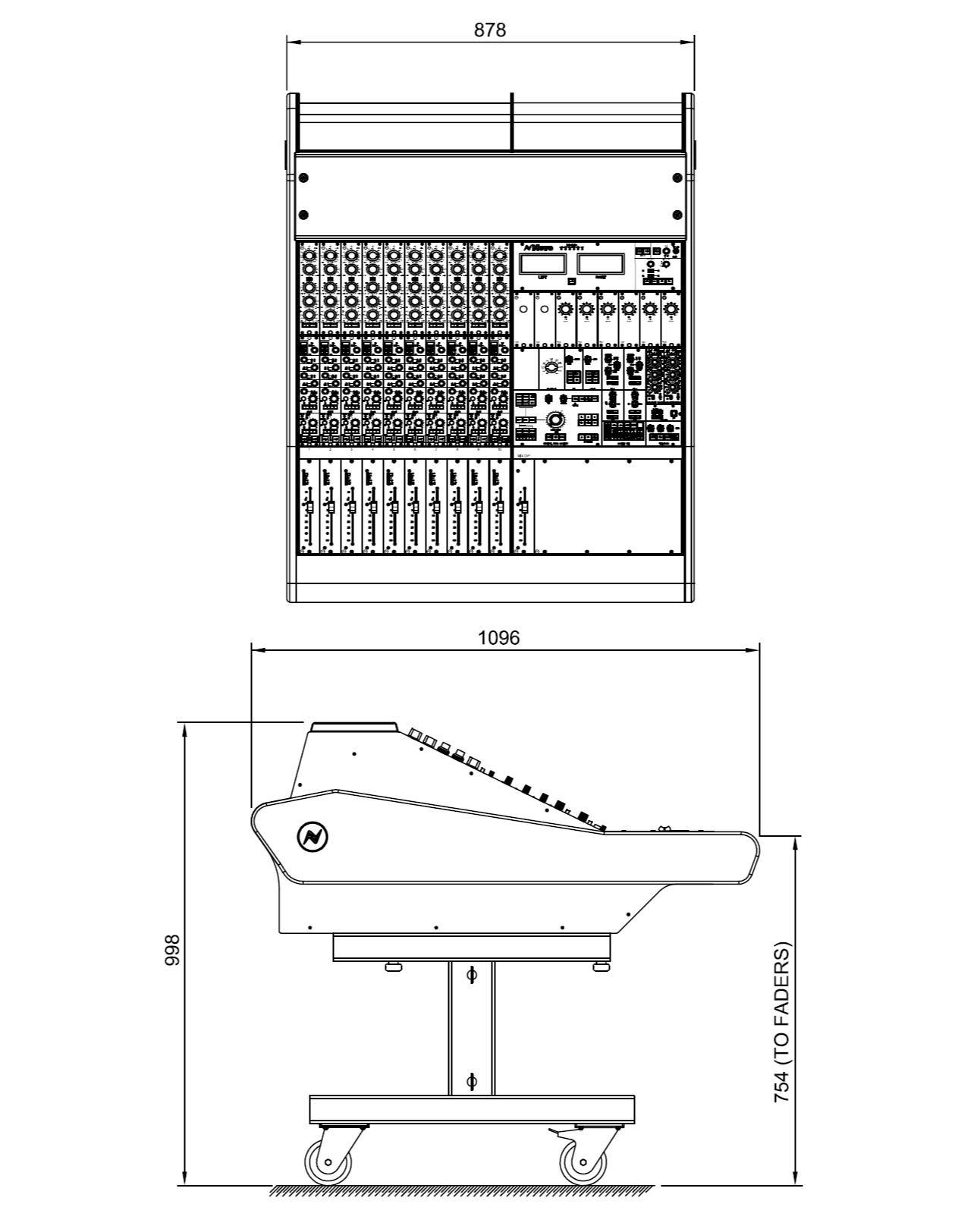
- Available with 10, 16, 24 and 32 channels
- Pair of matching cherry oak loudspeaker shelves to mount on top of the console
- Sidecar stand with lockable castors (32-fader stand has fixed feet)
Frequently Asked Questions
How does the modern BCM10 perform compared to the hand-wired 1969 model?
The modern BCM10/2 MkII performs precisely to the original 1969 model specifications; our designers painstakingly reverse-engineered the original console circuit-by-circuit, matching tolerances, performance and components every step of the way.
What is the maximum channel count of the BCM10?
The BCM10/2 MkII comes in several configurations depending on your studio requirements. Starting at 10 channels through 16, 24, 32 and even 48 for the larger studios. The console has producers table options which provides a platform to host a DAW computer for simple modern studio integration.
How many channels can I mix down through a 10 channel console?
The BCM 10/2 MkII includes a new, simple input feature, bringing in 10 additional transformer-balanced inputs through the mix bus. In addition, the stereo reverb returns can bring in another four transformer-balanced line inputs, totalling 24 inputs at mixdown! However, the expandability doesn’t stop there; using the two DI inputs, an external mixer can connect to the BCM10/2 MkII’s mix bus offering an almost unlimited mixdown channel count!
What Preamp and EQ modules can be installed into the BCM10/2 MkII?
There are three factory-fit module types to choose from – the 1073N, 1073 classic, or 1084 classic modules can be fitted to your console depending on your studio requirements. Vintage 80-series Neve modules that follow the original 18-pin layout can also be installed.
Can I install any 500 series module into the BCM's 500 slots?
The BCM10/2 MkII’s 500 series slots follow the VPR alliance specification; any module that follows this specification can be inserted. However, since the modules are applied as mix bus inserts, it is better to use 500 series processors such as compressors and EQ’s rather than preamps.
What does the 1073 module share with the 1272 module?
The 1272 module was primarily designed as a mix bus amplifier used to bring the low bus level (typically –40dBu) up to line level hence only requiring around 40dB’s of gain, with occasional use as a talkback microphone amplifier, never as a complete mic pre. The same amplifier PCB’s are used in the 1272 as are used in the 1073/1084 Channel module, which includes a full specification mic preamp; crucially, the higher gain required (up to 80dB) for the preamp module in the 1073 is achieved by using two mic amplifier stages in series.
Can I mix in 5.1 surround through the BCM10/2 MkII
No, not through the consoles mix bus. The BCM10 was a stereo-only console, and installing a 5.1 mix bus into the BCM/10/2 MkII would have been a step too far away from the classic design. However, the monitoring is fully 5.1 compatible, allowing the BCM10/2 to function as the primary monitor control for any 5.1 system.
Want to learn more about the BCM10/2 Mk2?
Please fill out this contact form and we will get back to you as soon as possible.
